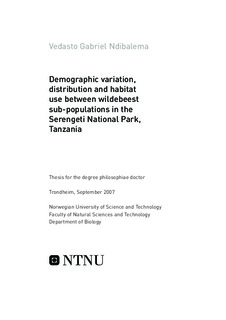| dc.description.abstract | This thesis investigates the demographic variation, distribution and wildebeest habitat use in the Serengeti National Park (SNP) and its adjacent protected areas in northern Tanzania. Specifically, the study i) examines whether life history strategies displayed by wildebeest sub- populations could cause variations in sex ratio and calf survival, ii) tests whether the orientation of wildebeest to spatial variations in food resources may have a considerable consequence on their body conditions when sub-populations and group sexes are compared, iii) investigates to what extent dust raised by moving vehicles affects the density and foraging distribution of grazers along the roads, iv) recommends management options suitable for conservation planning of migrating wildebeest.
The sex ratio in the resident sub-population was significantly more female biased than that in the migratory sub-population throughout the study period. Higher birth rates with a more synchronous birth season were more evident in the migratory than the resident sub-population, although in both cases they coincided with seasonal rainfall. Furthermore, a higher annual mean calf survival rate [estimate (0.49)] was recorded in the migratory sub-population than among the residents (0.31). The proportionately higher calf mortality in the resident sub-population can probably be attributed to predation resulting from asynchronous birth. Predator swamping from synchronous birth in the migrants appeared to be more important for the calf than yearling survivals, which was much lower (0.44) than in the resident (0.90) populations. Since birth seasonality in resident (December-January) and migratory (February-March) sub-populations appeared to be distinct, their different life forms strategies may have demographic consequences worsened by environmental and human factors.
Demographic variations between sub-populations were associated with nutritional differences among wildebeest individuals grouped into sexes and seasons. The residents were on the whole nutritionally better-off than the migrants, perhaps due to a better nutritional environment relative to the energetic costs of migrating. Equally, the timing of reproductive investment strategically differed between the sexes due to their life history traits. Nutritional costs associated with pregnancy, lactation and parental care constrained the body condition of females (through reproduction and survival) in the event of serious food shortage, in contrast to males who thrived comparatively better, even in relatively poor environments. Northward migration, motivated by food abundance, correlated with a south-north rainfall gradient as claimed by previous migration hypotheses.
Grazing along roadsides correlated negatively with the density of dust, which increased progressively with traffic volume and speed as seasons advanced. More dust gathered in the grass on the west than on the east side of the road, basically due to wind effects. Dust deposition was comparatively higher on the short grasses than the long grasses during the dry and late-dry seasons than during the wet season when paired distances (< 300m) were compared. However, most grazers fed further out on the west side due to higher dust densities on roadside swards than on the east side. This trend supported the ‘dust aversion hypothesis’, which states that grasses which trap a higher level of dust density are avoided as ungulates tend to feed further away from roads than expected from a random distribution. The test predictions from responsive behaviours of most grazers due to the ‘road disturbance’ and ‘road attraction’ hypotheses were not supported.
Notwithstanding a heterogeneous distribution of resources in the Serengeti ecosystem, habitat use at the ecosystem scale indicates regular selection for open grassland compared to other vegetation types, probably due to availability rather than actual preference. The use of open grassland appeared to be strongest in the Serengeti National Park (SNP), probably due to the level of protection coupled with productivity and nutritional suitability. Open woodland, bush with emergent trees and wooded grassland only served as important habitats during the critical period of food shortage. Resource selection in these habitat patches was largely dictated by grass greenness, the period of the day and the speed of wildebeest movement, which was sex related.
Thus, when managing wildebeest populations, effort should be made to control the effects of anthropogenic activities on the landscape and the wildebeest through habitat changes and demographic variations, respectively. In conjunction with the ongoing natural and man-made changes, wildebeest population viability models need to be in place so that managers can predict the future of the Serengeti wildebeest and their migration. | nb_NO |
